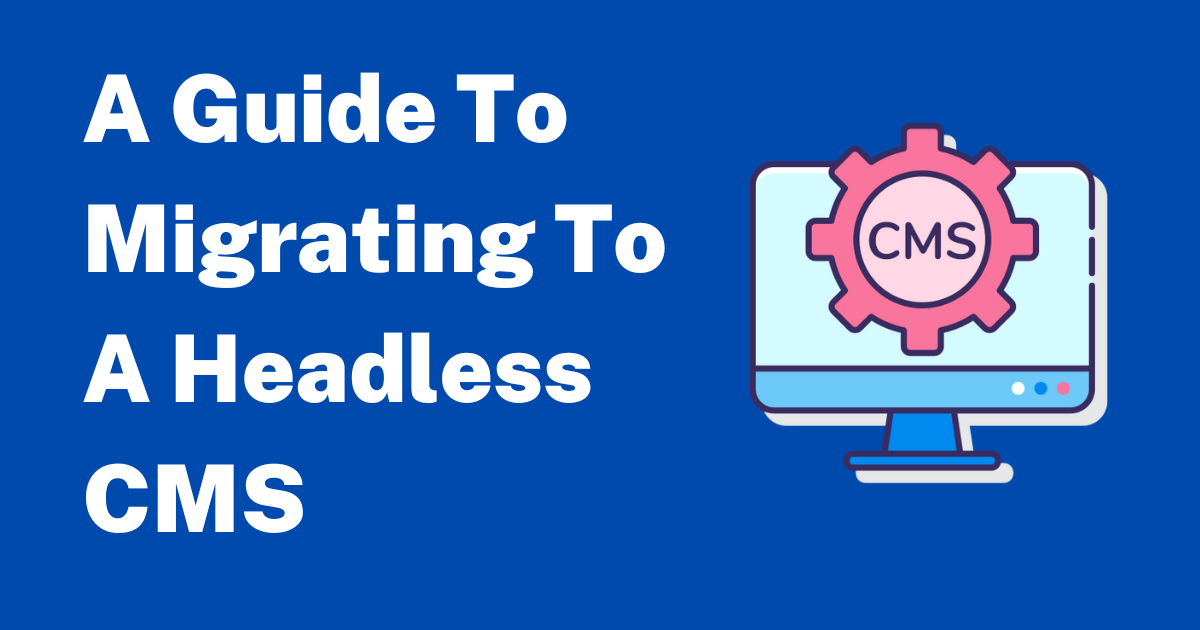A Guide To Migrating To A Headless CMS
Traditional CMS (content management system) structure might be stopping your organization from reaching to its full potential. If that’s the case, you can consider migrating to a headless CMS.
Now, the question is what’s the difference between headless CMS and traditional CMS? A traditional CMS is a monolithic content delivery system in which the front end and back end are coupled together. Talking about headless CMS, the frontend (presentation layer) and backend (content library) are separated from each other.
Many organizations nowadays consider CMS migration and switch to headless CMS because of increasing user demand.
Benefits of Migrating To A Headless CMS
Here are the reasons why migrating from traditional CMS to headless CMS is worth it:
- Performance: Decoupling the frontend from the backend prevents the need to load unnecessary code, and results in faster page loading speed. This is how migration to headless CMS can enhance performance.
- Flexibility: While traditional CMS is rigid as frontend and backend are coupled together, headless CMS offers great flexibility by decoupling them. It offers the flexibility to build your own front-end.
- Developer-friendly: Headless CMS gives you the ability to choose your desired framework, tools, programming language, etc.
- Increased Security: By eliminating the need to manage complex server-side technologies and reducing the attack surface area, headless CMS can enhance the overall security posture of your digital ecosystem.
- Omnichannel freedom: Unlike traditional CMS, headless CMS is not limited to content delivery channels supported by the CMS. It means your web content can be delivered in all the channels, including mobile phones, smart watches, AR/VR, etc.
Guide To CMS Migration
Now that you know the advantages of migrating to a headless content management system, let’s walk you through the process:
1. Analyze Current CMS Architecture
Before starting CMS migration, it’s crucial to understand your current CMS architecture thoroughly. Identify the platform you’re currently using and delve into its architecture. Evaluate the existing content structure, including how content is organized, the types of content supported, and any limitations or challenges you face with the current setup. Additionally, assess data volumes to understand the scale of the migration and determine user access levels to ensure that the new CMS will meet the needs of your users.
2. Establish Objectives
Define clear objectives for the migration to guide the process and ensure its success. Consider what you hope to achieve with the migration, such as improved performance, enhanced security, or better scalability. Setting realistic timelines and budget constraints is also crucial to ensure that the migration stays on track and within budget.
3. Define Content Strategy
A comprehensive content strategy is essential for a successful CMS migration. Start by taking inventory of your existing content to determine what needs to be migrated, archived, or updated. Create a detailed content migration plan that outlines workflows and responsibilities, ensuring that all stakeholders are on the same page. Consider SEO implications and plan for redirects if URLs are changing to minimize the impact on your search engine rankings.
4. Prepare Content for Migration
Before migrating your content, it’s essential to clean up and standardize content formats, metadata, and file structures. Ensure that your content is compatible with the new CMS requirements to avoid issues during migration. Additionally, backup all content and data to prevent loss during the migration process.
5. Select the Right CMS
Research and evaluate CMS options based on your requirements and budget. Consider factors such as ease of use, scalability, community support, and integration capabilities. Choose a CMS that aligns with your long-term goals and technical requirements to ensure a smooth transition and minimize the need for future migrations.
6. Determine Data Architecture of New CMS
Map out how your content will be structured in the new CMS to ensure a seamless transition. Plan for any necessary data transformations or migrations to ensure that your content is compatible with the new system. Additionally, ensure compatibility with existing systems and databases to avoid integration issues.
7. Prepare Backup Plan
Despite thorough planning, it’s essential to have a backup plan in case of migration issues or data loss. Backup all data before beginning the migration process and ensure that you have access to technical support during and after the migration to address any unforeseen issues.
8. Test, Review & Launch
Conduct thorough testing of the new CMS to ensure that all content and features function as expected. Solicit feedback from stakeholders and make any necessary adjustments before launching the new CMS. Once you’re satisfied with the testing and review process, launch the new CMS and monitor it closely for any issues post-launch to ensure a successful migration.
Final Thoughts
In a nutshell, a successful CMS migration demands proper planning as well as execution. By analyzing your current CMS architecture, establishing clear objectives, and defining a comprehensive content strategy, you can ensure a smooth transition to a new CMS.
Headless CMS differs from traditional CMS in such a way that the backend and frontend are separated from each other. As a result, it benefits in terms of performance, security, and flexibility.
